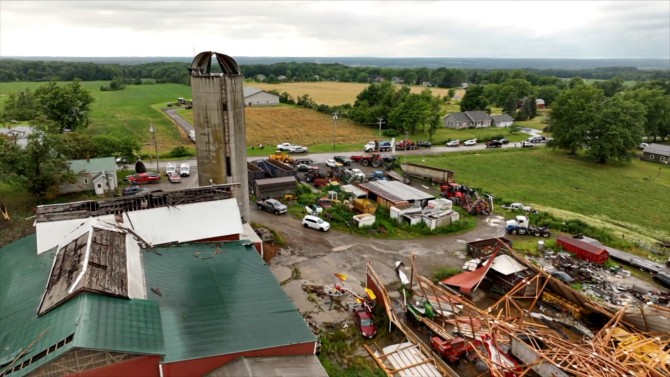As tornadoes touched down on July 10 in Eden, New York, Cornell Cooperative Extension Erie County staff huddled in its office building's basement, waiting for the severe weather warning to expire. A few miles down the road, farms were being leveled by 115 mile-per-hour winds, destroying barns, injuring cows and wreaking havoc.
After the storm ran its course, the team sprang to action.
"Our ag educators reach out directly to the farmers they have relationships with, and we offer information and resources to help them get through these kinds of emergencies," said Diane Held, CCE Erie County executive director.
In weather emergencies - including the snowstorms of 2014 and 2022 - CCE Erie County is responsible for relaying information from the agriculture community to the New York State Department of Agriculture and Markets, FEMA, Homeland Security and other state and federal partners who can respond and assist in times of crisis.
That same afternoon, 250 miles to the east in Lewis County, pouring rain flooded the village of Lowville as the local CCE county office was preparing for the annual county fair. A day earlier, the CCE Lewis 4-H team had organized and moved exhibits to the youth building. Now, parts of the fairgrounds were in standing water.
"We were at the office when we started to get reports about damage to the fairgrounds," said Michele Ledoux, CCE Lewis County executive director. "We divided up our staff, and our 4-H and Farm to School Coordinator helped out at the small animal and dairy barn with all the volunteers. We were trying to be community-minded, so the fair could go on as planned."
Ledoux also hit the road to support local county emergency management efforts, driving to area farms to survey damage and offer support. "We'll probably see some crop damage, but it was more community damage - washed out fences and bridges down, culverts destroyed," she said. "Lots of flooding in the village."
The responses to these latest storms by CCE Erie and CCE Lewis County are representative of CCE's statewide role in emergency management.
"We like to say, 'The more local a response can be, the better,'" said CCE Assistant Director Keith Tidball, who coordinates disaster education and preparedness for the organization. "A network of staff and experts all across New York state in our CCE County offices expedite and increase the amount of information we can share. Not only sharing information with folks directly affected by the crisis, but relaying local impacts back to state and federal partners."
Led by Tidball, CCE formalizes its statewide emergency response through the CCE All-Hazards Preparedness and Response Education Program (APREP) in tandem with the New York Extension Disaster Education Network (NY EDEN). In partnership with the Department of Agriculture and Markets, and the USDA-funded Extension Disaster Education Network, CCE is responsible for assisting in the gathering of information on damage and destruction in New York's agriculture sector - including damage to field crops, livestock and infrastructure that impact the state's ag economy.
"Cornell Cooperative Extension is a vital emergency response resource for New York's agricultural sector, thanks to its extensive network of specialists across the state and expert knowledge base," said Paolo Audino, New York State Department of Agriculture and Markets' emergency management coordinator. "Following damage due to extreme weather, CCE offers invaluable services like conducting thorough surveys of affected producers and sharing this information with our department to be sent to USDA."
These efforts jump-start and augment later efforts by USDA partners like the Farm Service Agency.
"I've been in meetings at 10 p.m. when disasters have struck, and sometimes I might get a call at 5 a.m.," Ledoux said. "We're expected to be able to provide answers to the county emergency management team when FEMA or Homeland Security has questions about what's going on with agriculture."
CCE offices can also help coordinate resources. "If a farmer needed sandbags, for example, they can call us and we put them in touch with our local Environmental Management Committee to get supplies," she said.
Once disaster response transitions to a recovery phase, Cooperative Extension offices also offer information and resources for recovery and future preparedness, many of which are provided by CCE APREP and distributed via NY EDEN.
"In November of 2014, after seven feet of snow dropped on Erie County, we shared a lot of information on recovery - like rebuilding with snow load in mind," Held said.
Information CCE Erie County gathered during the snowstorm helped inform local legislation securing $2 million in funding for impacted Erie County farms. Unspent funding will be used to cover uninsured damage to farms from the tornadoes.
"It's really about leveraging those relationships that we've built in the community and across the state to help out where we can," Held said. "I like to call CCE 'the great connector' because that's what we do best - connecting people with information and resources."
Melissa Jo Hill is a writer at Cornell Cooperative Extension.
Video footage courtesy of WKBW-TV.








